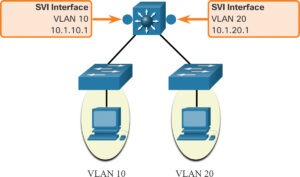
In complex network environments, where Virtual Local Area Networks (VLANs) are employed to segment network traffic for improved performance and security, inter-VLAN routing plays a vital role in enabling communication between different VLANs. Inter-VLAN routing allows devices in one VLAN to communicate with devices in another VLAN, facilitating seamless connectivity and efficient data transfer. This article explores the concept of inter-VLAN routing, its benefits, implementation methods, and considerations for network administrators.
Understanding Inter-VLAN Routing:
Inter-VLAN routing refers to the process of enabling communication between different VLANs using a router or a layer 3 switch. By routing traffic between VLANs, devices within each VLAN can exchange data packets with devices in other VLANs, effectively breaking the logical boundaries and facilitating inter-VLAN communication.
Benefits of Inter-VLAN Routing:
1. Enhanced Connectivity: Inter-VLAN routing enables devices in separate VLANs to communicate with each other, fostering collaboration and improving connectivity within a network infrastructure. It allows organizations to create logical groups of devices based on their requirements, such as separating departments or different security zones, while still maintaining the ability to communicate efficiently.
2. Efficient Resource Utilization: By utilizing inter-VLAN routing, organizations can optimize resource utilization. For example, centralized resources like servers or network storage devices can be placed in a specific VLAN while allowing other VLANs to access them when necessary. This approach reduces redundant resources and improves overall network efficiency.
3. Improved Security and Control: Inter-VLAN routing provides a mechanism to implement granular security policies between VLANs. Administrators can employ access control lists (ACLs) or firewall rules at the routing level to control traffic flow between VLANs, ensuring that only authorized devices or services can communicate across VLAN boundaries. This segregation helps contain potential security breaches and restricts unauthorized access.
Methods of Implementing Inter-VLAN Routing:
1. Traditional Router-on-a-Stick: In this method, a single physical interface of a router is connected to a switch that has multiple VLANs configured. The router interface is configured as a trunk port, allowing it to receive and transmit VLAN-tagged traffic. The router performs routing between VLANs by encapsulating and decapsulating VLAN tags, effectively acting as a gateway for inter-VLAN communication.
2. Layer 3 Switching: Layer 3 switches combine the capabilities of a switch and a router, allowing for efficient inter-VLAN routing. These switches have dedicated hardware and software features that enable fast routing between VLANs without the need for an external router. Layer 3 switches provide better performance and scalability for inter-VLAN routing in large network environments.
Considerations for Inter-VLAN Routing:
1. VLAN Configuration: Before implementing inter-VLAN routing, it is essential to configure VLANs correctly on the switches and assign the appropriate ports to each VLAN. VLAN membership and tagging should be consistent across all switches participating in inter-VLAN routing.
2. Routing Protocol Selection: If multiple routers or layer 3 switches are involved in inter-VLAN routing, choosing the appropriate routing protocol, such as OSPF or EIGRP, is crucial. The routing protocol allows routers to exchange routing information and dynamically update routing tables, ensuring efficient routing between VLANs.
3. Security Considerations: When implementing inter-VLAN routing, it is essential to establish proper security measures. Implementing ACLs, firewall rules, and other security mechanisms at the routing level helps control traffic flow and enforce security policies between VLANs.
Conclusion:
Inter-VLAN routing is a fundamental aspect of network design, enabling seamless communication and connectivity between different VLANs. It enhances network efficiency, optimizes resource utilization, and improves security and control within an organization’s network infrastructure. Network administrators should understand the concepts, implementation methods, and considerations of inter-VLAN routing to design and manage robust and scalable networks that facilitate effective inter-VLAN communication.

